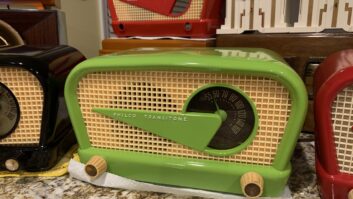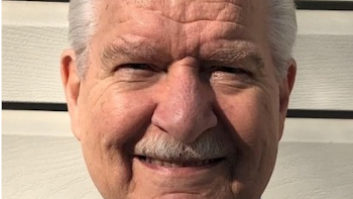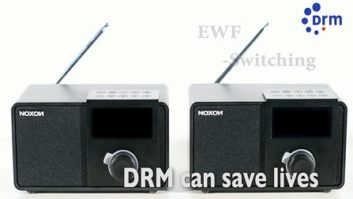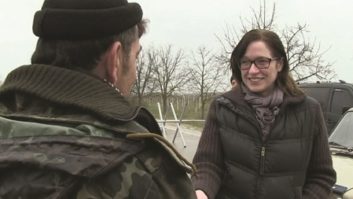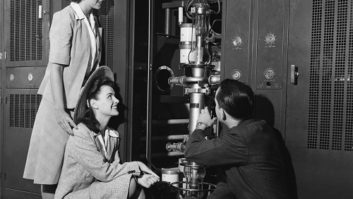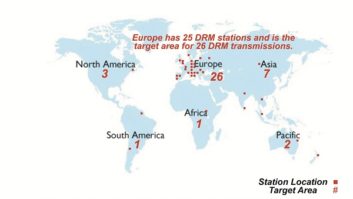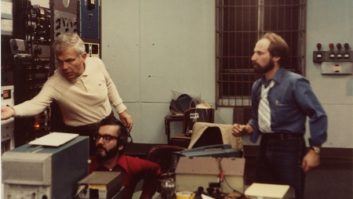The role of shortwave radio has been much debated by members of the U.S. international broadcasting community. Among those with a strong interest in the topic is George Woodard. I spoke with him about his life and experiences working with shortwave radio as both a manufacturer and an engineer for U.S.-sponsored broadcasts.
Woodard started out with Continental Electronics in the early 1960s in the midst of the Cold War, when shortwave radio was on the rise as a means to provide an alternate news source for people in the closed Soviet Union. He’d been drawn to radio as a boy, attended Texas Tech and received a degree in electrical engineering in 1962.

During his years with Continental, he helped develop many of the high-power shortwave transmitters that were an important part of radio and politics in that uneasy era of simmering conflict.
Years later, in 1985, Woodard left the manufacturer to become associate director for engineering for Radio Free Europe/ Radio Liberty and was promoted to VP of RFE/RL Engineering in 1987, just before the conclusion of the Cold War.
After jamming of shortwave broadcasting by the Soviet government ceased in 1988, Radio Free Liberty reached a peak of nearly 35 million weekly listeners, bringing news about the West and democracy to the countries of the former Eastern Bloc.
Woodard eventually worked his way up to director of engineering for the United States International Broadcasting Bureau. He returned to Continental as its vice president of engineering in 2000 and retired from the company in 2003. He now lives in McKinney, Texas, with his wife Christina. He continues to play an active role in the broadcast industry through his research and writing.
How did you come to work for Continental Electronics upon your graduation from Texas Tech?

Final amplifier tube, tuning capacitor and 45 kV protective ball gap set at approximately 1.5-inch My mother and father were church friends with Mark and Catherine Bullock, and Mark Bullock was VP of engineering at Continental Electronics when I was in about the 7th grade in 1952. I remember Mr. Bullock taking me on a visit of Continental one weekend when I was in high school, and I saw the two huge curtain array antennas there that would ultimately end up at the Voice of America station in Greenville, N.C.
My dad was an electrical engineer for Southwestern Bell Telephone Co., and he got me interested in basic electronics, but it was Mr. Bullock who first introduced me to high-power electronics, broadcast and amateur radio, and I was hooked.
What was it like working at Continental in the 1960s?
Continental was founded in 1946 by James Oliver Weldon, who had been technical director of the Office of War Information, the predecessor of the VOA, during World War II. Mr. Weldon’s interest had always been in super-power AM broadcasting, and it was his idea to concentrate on that market for the U.S. government and international broadcasters with some success at the beginning.
However, it soon became evident that the broadcast market alone would not be enough to provide and sustain the desired company growth, so alternatives were pursued and Continental Electronics won an award to build a high-power radar system for the Ballistic Missile Early Warning System, with great success. That success led to Continental Electronics becoming a consistent and viable competitor for any high-power radio or radar system for the U.S. government without regard to frequency range or purpose, and since then, Continental has participated in more U.S. military radar systems than I can recall.
I came to Continental Electronics in June of 1962, and the first project I worked on was the Nike-Zeus Anti-Ballistic Missile Acquisition Radar, a direct and natural response to the highly successful Ballistic Missile Early Warning System effort I mentioned. This program, however, was canceled by the Pentagon in 1963 when it realized that the total scope of the project was beyond the technology of the time. Even today, almost 50 years later, it is only marginally feasible at a reasonable cost!

Four turn pi network output inductor on the model 419F, 250 kW transmitter Then, as fate would have it, I became involved in high-power shortwave transmitters.
What drove Continental into that arena?
In about 1963, the Voice of America had stated their intent to buy perhaps up to 100 250 kW shortwave transmitters in the next 20 years, and had issued a new technical specification for this planned procurement.
Continental Electronics, under Mr. Weldon’s guidance, had produced 12 250 kW shortwave transmitters for the VOA in the 1950s, four of which had been diverted to upstart Radio Liberty for their dedicated broadcasts of truth and freedom to the citizens of the Soviet Union. But these 12 transmitters, while basically successful, were also not without their problems. The new VOA specifications ruled out the use of a Doherty-type amplifier system, which the original 12 transmitters used. The new specifications allowed only plate modulation of the final amplifier, requiring Continental to go back to the drawing board for a new design.
I was assigned to work on the project, and we built a prototype transmitter designed to meet the new VOA specifications and sold the prototype to Trans World Radio, at cost, for use at their newly acquired Bonaire, Netherlands Antilles relay station.
To make a long and miserable story short, the transmitter never worked well — perhaps because I worked on it — but nevertheless, due to brilliant and dedicated work by Trans World Radio staff over the years, it managed to provide at least a degree of service toward their mission.
Continental Electronics did not win any part of the pending VOA transmitter procurement, which was split instead between Collins Radio and Hughes Aircraft, neither of which had ever built a super-power broadcast transmitter.
It turns out the Collins transmitter was basically a superior design with one major, though debilitating, fault; and the Hughes product was an even bigger disaster than the one Continental Electronics came up with. Rumor has it that Collins Radio, recognizing their debilitating mistake, offered to correct it with a truly superior design to the U.S. government, at cost, and was rejected. This was my first foray into U.S. government procurement practices, where incompetent technocrats, legalcrats and bureaucrats, were calling the shots. It would not be my last.

George Woodard stands in front of one of the four 419F transmitters at Holzkirchen, Germany in 2003 What projects did you work on next?
As any design engineer I think will attest, we learn from our mistakes as much if not more than from our successes. I have often looked back on the disastrous Trans World Radio transmitter — it was not so easy to joke about it in real time — and jokingly said that I learned 90 percent of what not to do on that one project. My next project was for four 100 kW transmitters for the international broadcasting arm of the government of Portugal, Emissuora Nacional.
The problems with the aforementioned Trans World Radio transmitter were myriad, but one of the most egregious was the choice of the final tubes. The VOA-selected Collins Radio transmitter used newly generated Eimac 4CV100000C tetrodes, which were the brainchild of my marketing mentor Jack Quinn, marketing director at Eimac. Rumor had it that the last “C” in the part number stood for Collins. I can’t confirm that. Nevertheless, I wanted to use the tetrode tubes in the 100 kW design, and after a little political maneuvering, I won. The transmitter was the 418B, Continental Electronics’ nomenclature for an HF-100 kW, Model B. The highly successful, though not perfect, Model B replaced a Model A version that was being built for Pakistan, circa 1966. It is still being produced today some 44 years later with a solid-state modulator and is capable of digital modulation for use with, for example, DRM.
In 1978, I was privileged to be able to build the 418’s big brother, the 419C, a 250 kW shortwave transmitter for Radio Free Europe/Radio Liberty. Radio Free Europe/Radio Liberty purchased 19 of the 419s, 15 at Glória, Portugal and four at Holzkirchen, Germany.
The 418B, 419F and later 420C transmitters had basic similarities. They all had single-tetrode final Class-C RF amplifiers. The 418s and 419s originally had tetrode Class-AB modulators, the Eimac 4CV100000C in both, and both later employed amplitude crossover pre-distortion, which essentially converted the modulators to Class-B for improved program efficiency. The 500 kW 420C, circa 1984, which I never saw completed before I left Continental Electronics, used a single-tetrode pulse-width modulation modulator. All three, the 418D, the 419F and 420C, were converted to Continental Electronics’ patented and quite remarkable solid-state modulator system in the late 1980s.
The 418B and the 419D, and later models, employed a quite unique band-switched coil of my design which “massacred” back-turn spurious resonances that can be so harmful and potentially destructive in high-power RF circuitry. The 420C used an equally unique design first used at Collins Radio for their highly successful 250 kW shortwave transmitter — a coupled distributed variable transmission line network that inherently reduced spurious and harmonic resonances.
Continental Electronics bought the Collins Broadcast Division in about 1980. Collins Radio engineers pioneered the use of tetrode amplifiers for use in their high-power single-sideband linear amplifiers, and with that effort promoted the grounded screen for increased amplifier stability. However, the grounded screen arrangement made it difficult for AM transmitters, which employed anode and screen modulation.

Holzkirchen Station As a result, my good friend and colleague Tom Lowrey and I developed a practical way to bypass the screen to ground and RF frequencies, with equal stability to the grounded screen approach, while still allowing the screen to be modulated at audio frequencies. This same technique of bypassing the screen grid was also used on the very successful one-half and one megawatt medium-wave Screen Modulated Doherty transmitters, Continental Electronic models 320 and 323, in the Middle East in the late 1970s and early 1980s. All three shortwave models, the 418G and DRM, the 419G, and 420C and D are all still in Continental Electronics’ product line after more than 40 years since the 418B was first built.
In addition, the 420C/D, without a modulator, forms the basis for a highly successful 500 kW over-the-horizon radar transmitter employed by the U.S. Air Force.
Are there special design considerations that come into play when working on super-power transmitters?
There are special design considerations for high power, of course. As with almost every discipline, experience is the best teacher. The first thing is that mistakes are more expensive. I remember well tests we did on the Nike-Zeus program. The Varian high-power klystrons cost $120,000 each and operated at 140,000 volts DC. They were “crowbar” protected against internal gaseous arcing, and one crowbar failure could mean $120,000. This was in 1962/63 when the average entry EE salary was around $6,000, so $120,000 was real money!
Besides the cost factor, there are the basic and obvious high-voltage and high-current factors to deal with. The textbooks say that 1 inch in air should hold off approximately 80,000 peak volts, but practice yields something much different when reliability of operation is a factor. Voltage breakdown is affected by humidity, dust, air pressure, frequency and many other factors. If the goal is 99.99 percent reliability or 1,000 hours mean time between failures, a lot more spacing than 1 inch per 80,000 volts is needed.
The skin depth of current is the same, of course, as in lower-power equipment operating at the same frequency, but power losses in conductors are related by the square of the current. This causes the conductors to become quite large to avoid excessive loss, and hence the conductors and capacitors can no longer be treated as “lumped” inductor or capacitor components, but rather as distributed networks with transmission line characteristics.
That is the answer in a nutshell. Working at the 100 kW level at VHF or 1000 kW at HF or medium wave is similar to low-power microwave applications in many respects, with the added factor of increased heat load and voltage breakdown. It is fascinating and challenging.
Why did you decide to move to Radio Free Europe in 1985?
The complete reason for the move is complex and multi-faceted. I had known of Radio Free Europe/Radio Liberty from having sold, installed and periodically serviced the 100 and 250 kW shortwave transmitters Continental Electronics sold to them. I dropped in on them whenever I was traveling to and from the Middle East for megawatt medium-wave projects Continental Electronics was involved in, and I got to know and respect their engineers as well as journalists in Germany, Spain and Portugal. And they, in turn, knew me.
They made me an offer of employment, and as the saying goes, I couldn’t refuse. Not money-related, but rather, I couldn’t pass up the opportunity for my family to experience Europe as I had experienced it, and it turned out to be the best career decision I could possibly have made. Ronald Reagan was president; he understood the value of communicating ideals and truth, and he had expanded the technical modernization budgets of both the VOA and Radio Free Europe/Radio Liberty. It was the correct decision at the correct time and turned out to be more correct than I could ever have imagined.

Woodard with Holzkirchen manager-to-be Wilhelm Rüther and Senior Maintenance Supervisor Hans Stöckl in front of a 419F. Stöckl was a fan of American western movies and Woodard brought him the Stetson hat on one of his visits to RFE/RL in 1981. Radio Liberty was originally called “The American Committee for the Liberation of the Peoples of Russia from Bolshevism.” Several iterations of name changes finally ended with Radio Liberty. I am forever indebted to Radio Free Europe/Radio Liberty Presidents Gene Pell and Kevin Klose for their support of me in the U.S. international broadcasting arena — to Gene for first appointing me as engineering VP for Radio Free Europe/Radio Liberty, and to Kevin for keeping me there and allowing me to follow him to the U.S. International Broadcasting Bureau. Both are giants in international political broadcasting with accomplishments too numerous to mention.
Why is shortwave still important and what should we be doing today to preserve it?
That is a very good question that our leaders in Washington should instead be asking.
The immediate preliminary answer is that it’s not as important as it once was, though still very important. Our leaders in Washington have been unable to get beyond the first half of the above answer since 1989 and the collapse of Soviet-style communism. It is still very important.
Washington, driven by incompetent technocrats and bureaucrats at the IBB and the U.S. Department of State, who are experts at saying what they perceive people want to hear rather than the truth, has taken a wrong turn on shortwave broadcasting since about 1989. The result has been a kind of self-fulfilling prophecy. As we close down most shortwave broadcasting to parts of the world, it is no surprise that 20 years later we find fewer people are listening!
My advice is to pursue vigorously all new technological means to communicate accurate world news to the parts of the world that do not have that blessing of their own. Expand Internet, TV, local AM and FM, Wi-Fi and cell phone broadcasting, but do not significantly reduce shortwave. In many instances, as has been recently seen in Iran, Belarus, Georgia, Pakistan and other places, and chronically seen in parts of Russia, China and North Korea, increased shortwave capability is critical.
The cost of shortwave broadcasting is often brought up as a concern. Let me close with some perspective on that argument.
The cost of operating a nominally large shortwave station is approximately $15 million per year. Ten stations cost about $150 million to operate annually. With modernization and a degree of automation, it could be reduced to approximately half that. If shortwave broadcasting could contribute to reducing our global military effort by just 1 percent, we, as a country, would still save approximately $4.85 billion annually, assuming a $500 billion annual military budget, not to mention the lives of American soldiers.
I think it would perhaps be wiser for the American government to spend the little money on shortwave to help keep us out of shooting wars.

